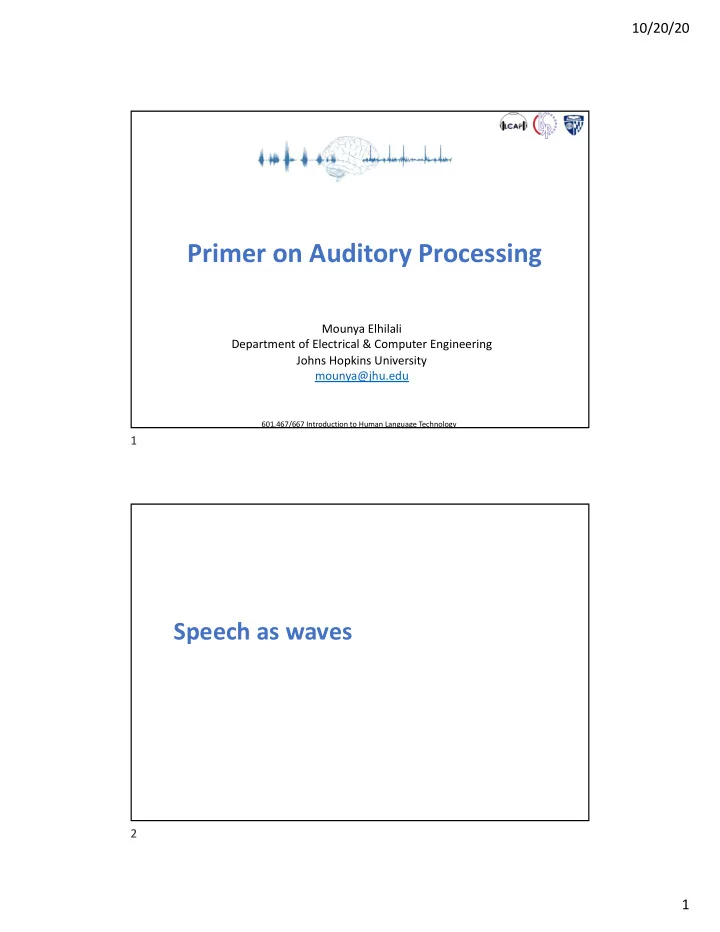

10/20/20 Primer on Auditory Processing Mounya Elhilali Department of Electrical & Computer Engineering Johns Hopkins University mounya@jhu.edu 601.467/667 Introduction to Human Language Technology 1 Speech as waves 2 1
10/20/20 Sound is a wave • Sound is a mechanical wave caused by a vibrating source • The vibrating source that causes the matter around it to move • No sound is produced in a vacuum • Matter (air, water, earth) must be present • Individual air molecules do not move with the wave. A given molecule vibrates back and forth about a fixed location. 3 3 Sound waves Period of oscillation Sound Pressure High Normal Low Time • Motion air particles do not travel, they oscillate around a point in space • The rate of oscillation is called frequency (f) ü denoted in cycles per second (cps) or hertz (Hz). 5 5 2
10/20/20 Physical Dimensions of Sound Period (T) Amplitude Frequency (F) Wavelength (λ) • Height of a cycle • Cycles per second • Distance traveled by one cycle 6 6 Perceptual dimensions of Sound Physical Properties of Sound Perceptual Dimensions Amplitude/Intensity Loudness Frequency Pitch Complexity Timbre (frequency content & time) 7 7 3
10/20/20 Sounds in the environment Note: Listening to loud music will gradually damage your hearing! 8 8 Equal Loudness Curves/Contours Loudness (dB) Each contour represents equally-perceived tones 9 9 4
10/20/20 Pitch • At first approximation, the pitch of 1 f a simple periodic signal is determined by its frequency. 2 f 1 octave • Most oscillators (guitar string, vocal chords) naturally oscillate at 3 f a fundamental frequency ( 𝐺 ! ) as well as its integer multiples (called 4 f harmonics/partials/overtones). 2 octaves • The pitch of a complex period 8 f signal is often determined by its 3 octaves fundamental frequency ( 𝐺 ! ) 10 10 a Pitch scale • Perceptual scale of pitch: mel scale • How far in frequency do we have to be in order to feel a tone as doubled in pitch? It’s a relative scale, based on pitch comparisons ü Mel-scaling is used in signal processing to build filters that approximate human pitch perception (MFCC) 11 11 5
10/20/20 Masking • Hearing phenomenon • When the perception of one sound is affected by presence of another sound • one sound being masked by another • Term masking is used to describe effects of noise and interference in sound perception • We experience masking everyday 12 12 Masking 13 13 6
10/20/20 How do we perceive sounds? 17 The auditory system • Two major components in the auditory system • The peripheral auditory organs (the ear) • Converts sounds pressure into mechanical vibration patterns, which then are transformed into neural firings • The auditory nervous system (the brain) • Extracts perceptual information in various stages 18 18 7
10/20/20 Auditory Pathway 19 19 20 20 8
10/20/20 21 21 The ear • The ear is the organ of hearing • It changes sound pressure waves from the outside world into a signal of nerve impulses sent to the brain. • It consists of 3 components: • Outer ear • Middle ear • Inner ear 22 22 9
10/20/20 Organ of hearing outer ear – The external ear plays the role of an acoustic antenna, – It diffracts and focuses sound waves (pinna), while the ear canal acts as a resonator => amplifies sounds in 2-5 kHz range – The end of the canal has an eardrum which vibrates with sound 23 23 Organ of hearing middle ear – Eardrum (or tympanic membrane) vibrations cause mechanical motion of the small bones of the middle ear (malleus, incus & stapes) [3 smallest bones in the human body] – The middle ear acts as an impedance adapter to adjust energy difference between air environment and fluid environment 24 24 10
10/20/20 Organ of hearing inner ear • Cochlea translates physical vibrations into electrical signals for the brain to process • Cochlea acts a frequency analyzer of sound signals 25 25 The Cochlea - The cochlea is the inner ear organ that converts sound waves into neural signals. - The neural signals are passed to the brain via the auditory nerve. 26 26 11
10/20/20 Cochlea as frequency analyzer 28 28 32 32 12
10/20/20 Ascending pathway § Very complex. Just some major pathways shown. § Extensive binaural interactions § General principle: ü Increasing complexity of responses (like vision, touch) 33 Ascending pathway FUNCTION Identify and process complex sounds Principle relay to cortex Form full spatial map Locate sound sources in space Start sound feature processing Sound sensor / periphery 34 13
10/20/20 Tonotopy • Tonotopic map: • topographic organization (spatial arrangement) of where sound is processed • Derived from Greek tono/topos = place of tones • Most nuclei along auditory pathway from cochlea to A1 are tonotopically organized (inherit cochleotopy from periphery) 35 35 Auditory tonotopy • Adjacent cells in A1 form a frequency-map, similar to the one observed in the cochlea. A1 Cochlea 36 36 14
10/20/20 Encoding speech modulation beyond the cochlea Range of Temporal modulations MGB Cortex Midbrain Auditory nerve IC NLL LL Slow Medium Fast TB DCN PVCN AVCN 30 Hz 300 Hz 3000 Hz 39 Speech carries information at multiple levels • Any speech signal can be separated into two signals. = Example of good decomposition… A non-trivial task 40 40 15
10/20/20 Speech carries information at multiple levels • Any speech signal can be separated into two signals. • The envelope is the amplitude of the sound • The fine structure is the detailed waveform, without its envelope 41 41 16
Recommend
More recommend